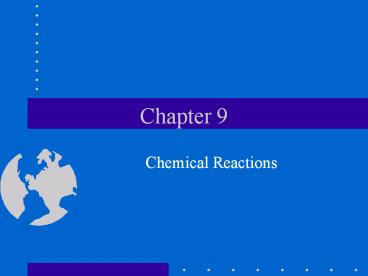Chemical Reactions - PowerPoint PPT Presentation
1 / 23
Title:
Chemical Reactions
Description:
Chapter 9 Chemical Reactions 10.1: Reactions & Equations Objectives Recognize evidence of chemical change Represent chemical reactions with equations Balance chemical ... – PowerPoint PPT presentation
Number of Views:233
Avg rating:3.0/5.0
Title: Chemical Reactions
1
Chapter 9
- Chemical Reactions
2
9.1 Reactions Equations
- Objectives
- Recognize evidence of chemical change
- Represent chemical reactions with equations
- Balance chemical equations
3
What is a chemical reaction?
- It is the process by which the atoms of one or
more substances are rearranged to form new,
different substances. - A chemical reaction is a chemical change!
4
The 4 signs
- There are 4 kinds of observations that indicate a
chemical reaction may have taken place. - A change in energy A
- temperature change is often
- used to determine if
- energy was released
- or absorbed. In addition,
- release of light also indicates
- an energy change.
5
The 4 signs
- 2. A color change
6
The 4 signs
- 3. Production of a gas may be observed as
- bubbling or visible fumes. Detection of an
- odor also indicates a gas was produced.
7
The 4 signs
- 4. Formation of a precipitate (or appearance
- of a solid) in a solution that was
- previously clear.
8
Practice
- Recall burning magnesium as part of a lab
activity. What evidence was there that a
chemical reaction occurred?
9
Review
- Equations represent chemical reactions.
- Reactants (on the
left) are the starting
substances. - Products (on the
right) are the
substances formed
during the reaction.
10
Review
- An arrow shows the way the reaction progresses
It is found between the reactants and products
and is usually read as yields. - signs are placed between each reactant and
product They are read as and.
11
Review
- Symbols are often used after each reactant and
product to indicate their state. - (s) for solid - (g) for gas
- (l) for liquid - (aq) for water
solution
12
Review
- Coefficients are
whole numbers
written in front
of formulas in the
equation. They
indicate the
number of atoms,
molecules, or ions
of that
substance
that are involved in the reaction.
13
Practice
- Identify the reactants and products and, using
words not formulas, interpret the following
equations. - Mg (s) H2SO4 (aq) ? H2 (g) MgSO4 (aq)
- C(s) 2ZnO (s) ? 2Zn (s) CO2 (g)
14
Types of Equations
- Word Equation words are used to summarize the
reaction. - Ex. iron chlorine iron (III)
chloride - Ex. carbon sulfur carbon disulfide
- Skeleton equation Chemical formulas are
substituted for words. - Ex. Fe Cl2 FeCl3
- Ex. C S CS2
15
Skeleton Equations
- Skeleton equations are also called unbalanced
equations because they do not obey the Law of
Conservation of Mass. - Fe Cl2 FeCl3
-
- 1 iron atom 2 chlorine atoms
-
1 iron atom -
3 chlorine atoms
16
Practice Problems
- Write skeleton equations for the following
- - hydrogen bromine hydrogen bromide
- - carbon monoxide oxygen carbon dioxide
- - potassium chlorate potassium chloride
-
oxygen - 4 Manganese metal reacts with sulfuric acid to
produce manganese (II) sulfate and hydrogen gas. - 5 Silver nitride is produced when silver reacts
with atmospheric nitrogen.
17
Types of Equations
- Balanced chemical equation This equation shows
that the number of atoms of each reactant and
each product is equal on both sides of the arrow. - 2Fe 3Cl2 2FeCl3
- 2
iron atoms - 2 iron atoms 6 chlorine atoms
6 chlorine atoms
18
Balanced Chemical Equation
- This is defined as a statement that uses chemical
formulas to show the identities and relative
amounts of the substances involved in a reaction.
- Balanced chemical equations obey the Law of
Conservation of Mass.
19
Steps to Balancing Equations
- - Write a skeleton equation.
- Problem Hydrogen and chlorine combine
- to form hydrogen chloride
- H2 Cl2 HCl
- Recall there are 7 elements that
- exist as diatomic molecules.
20
Steps to Balancing Equations
- - Determine the number and kinds of atoms in the
reactants. - - Determine the number and kinds of atoms in the
products. - H2 Cl2 HCl
- 2 H 1 H
- 2 Cl 1 Cl
21
Steps to Balancing Equations
- - Change the coefficients (never the subscripts)
until the number of atoms of each element is
equal on both sides of the equation. - H2 Cl2 2HCl
- 2 H 2 1 H
- 2 Cl 2 1 Cl
22
Steps to Balancing Equations
- - Make sure the coefficients are in the lowest
possible ratio. Reduce if necessary. - - Go back and add the atoms up again. Make sure
the number of atoms of each element is equal on
both sides of the arrow. - If you cannot balance the equation, go
back and make sure your formulas are written
correctly!!
23
Practice Problems
- - Sodium hydroxide and calcium bromide react to
produce solid calcium hydroxide and sodium
bromide. - - Carbon disulfide reacts with oxygen gas to
produce carbon dioxide and sulfur dioxide. - - Zinc and sulfuric acid react to produce
hydrogen gas and zinc sulfate. - - Iron (III) chloride reacts with sodium
hydroxide to produce iron (III) hydroxide and
sodium chloride.































